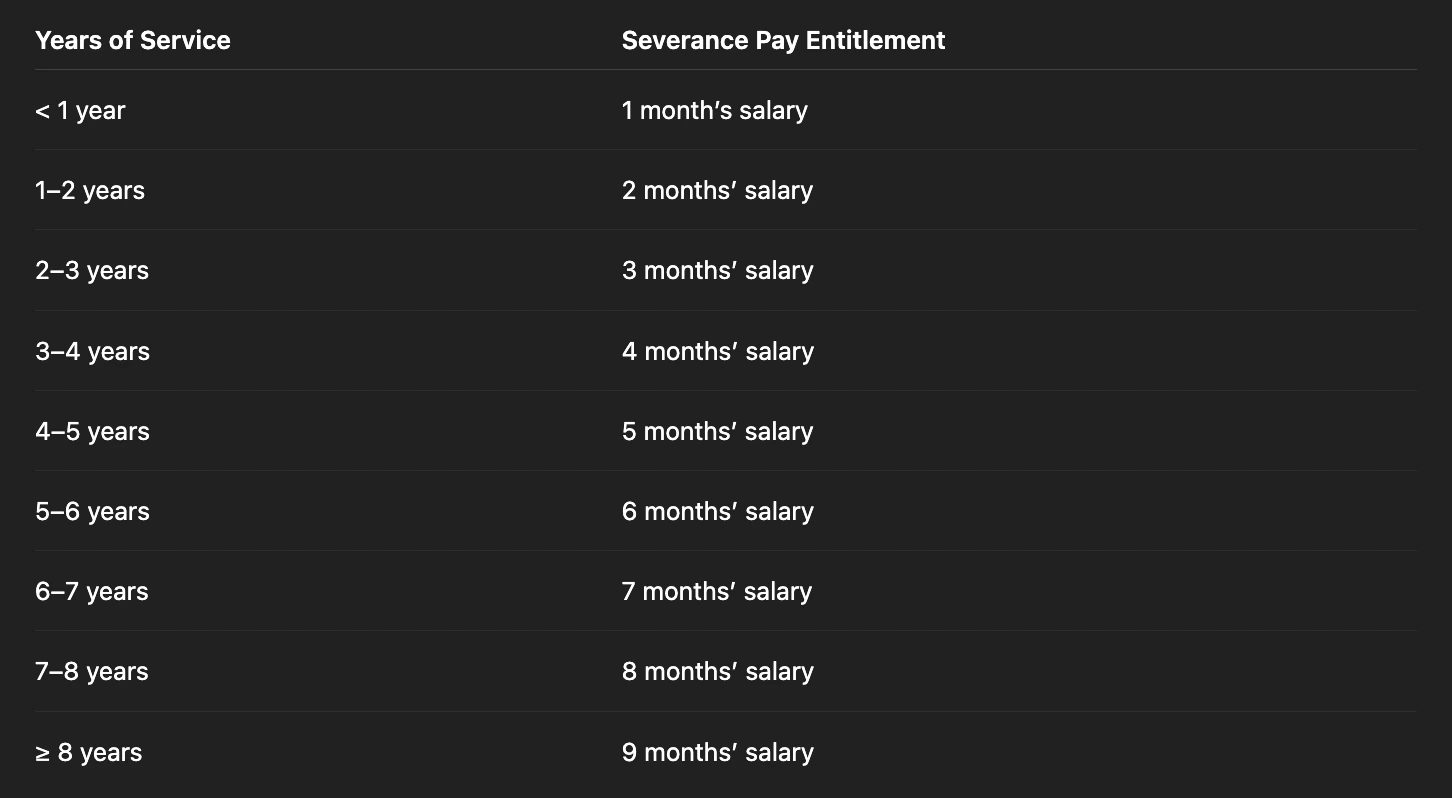Smart Ways to Manage Severance in Indonesia 2025: Common Disputes and How to Resolve Them Before They Escalate


Introduction: Rising Risks in Severance Disputes
For many foreign companies operating in Indonesia, severance seems like a simple final payout — a financial formality to end an employment relationship. Yet, reality often proves more complex. Miscalculating Severance in Indonesia, overlooking documentation, or mishandling termination procedures can quickly escalate into costly legal disputes.
In recent years, Indonesia’s labor courts have seen a rise in claims related to unpaid or miscalculated severance, often involving multinational firms that underestimated the country’s strict employment regulations. These disputes can result in large compensation orders, operational delays, and reputational harm, especially when cases become public. Beyond financial penalties, the impact extends to workforce morale and investor confidence, highlighting that severance is not just an HR concern—it’s a legal and strategic risk.
Understanding Severance in Indonesia requires more than knowledge of payout formulas; it demands a clear grasp of termination grounds, documentation standards, and the lawful procedures under Law No. 13/2003 (Manpower Law) as amended by Job Creation Law No. 6/2023 and its implementing regulations.
This article explores how businesses can handle Severance in Indonesia correctly—by ensuring compliance, proper documentation, and fairness in employee termination. Done right, severance becomes not a liability, but a reflection of professionalism and respect that protects both the employer and the employee, while preventing unnecessary disputes in 2025 and beyond.
Legal Framework: Severance in Indonesia
Understanding the legal foundation of Severance in Indonesia is crucial for any company, especially those led by foreign directors unfamiliar with local labor norms. The key regulation governing severance is Law No. 13 of 2003 on Manpower, as amended by the Job Creation Law No. 6 of 2023 and its implementing regulation, Government Regulation (GR) No. 35 of 2021. These laws outline the calculation, eligibility, and conditions for severance entitlements while aiming to balance the rights of both employers and employees.
Under these provisions, Severance in Indonesia generally consists of three main components:
- Severance Pay (Uang Pesangon): Compensation based on the employee’s length of service, typically ranging from one to nine months of salary depending on tenure.
- Long Service Pay (Uang Penghargaan Masa Kerja): Additional compensation for employees who have served more than three years, rewarding loyalty and tenure.
- Compensation for Rights (Uang Penggantian Hak): Covers unused leave, relocation costs, or other entitlements stipulated in the employment agreement or company policy.
Severance obligations arise primarily in employer-initiated terminations that are not caused by employee misconduct. These include terminations due to business efficiency, company closure, or redundancy. However, for terminations due to serious misconduct, severance may not apply, though companies must still follow procedural fairness and documentation standards to avoid disputes.
Recent updates—such as the Supreme Court Circular (SEMA) No. 3 of 2023—offer further clarity, particularly on fixed-term employment contracts (PKWT). If such contracts end prematurely without employee fault, the employer must pay the remaining balance of the contract, ensuring fair treatment for temporary workers as well.
For foreign businesses, understanding Severance in Indonesia goes beyond the formulas. Compliance means recognizing the local interpretations of fairness, proportionality, and documentation. As employment disputes increasingly reach the Industrial Relations Court, companies must be diligent in applying the latest regulations to avoid the financial and reputational fallout of wrongful termination claims.
Common Causes of Disputes Over Severance
Many severance disputes in Indonesia stem not from malice, but from misunderstanding or administrative oversights. Foreign businesses, in particular, often face legal challenges when unfamiliar with Indonesia’s detailed labor regulations and procedural requirements. Below are the most common triggers of severance disputes that foreign companies should be aware of.
One of the most frequent issues is improper calculation. Employers sometimes apply incorrect formulas—forgetting to include long service pay or miscalculating compensation for rights. Even a minor error can escalate into a formal dispute if an employee feels underpaid, especially when the total involves multiple years of service.
Another common cause is the absence of a written employment contract or the use of vague, generic terms. In Indonesia, the contract defines the employment relationship. Without clear provisions on termination, notice periods, or severance obligations, the employer’s position weakens in court.
Disputes also arise when terminations occur without valid legal grounds or when procedural steps are skipped. Employers must issue written warnings (usually up to three, unless serious misconduct is proven) and conduct a bipartite negotiation with the employee before termination. Failure to follow these steps can render a dismissal unlawful—even if the business rationale was sound.
Another hot spot involves fixed-term contracts (PKWT). If a contract ends prematurely and not due to the employee’s fault, the employer is legally required to pay the remaining balance of the contract term, as reinforced by Hogan Lovells and PNB Law Firm analyses.
Finally, many disputes stem from poor documentation of “compensation for rights”, such as unused annual leave or relocation costs. Without proof of payment or acknowledgment from the employee, companies risk claims of unpaid entitlements.
For foreign employers, understanding these pitfalls and maintaining transparent documentation are the best defenses against severance-related litigation in Indonesia.
How to Accurately Calculate Severance in Indonesia
Understanding how to correctly calculate severance in Indonesia is essential to avoid costly disputes and maintain compliance with labor regulations. The calculation is governed primarily by Law No. 13 of 2003 on Manpower, as amended by the Job Creation Law and further clarified under Government Regulation (GR) No. 35 of 2021. Employers must be familiar with the three major components of severance-related payments: severance pay, long service pay, and compensation for rights.
1. Severance Pay (Uang Pesangon)
The general severance in Indonesia formula is based on an employee’s length of service. According to Tampubolon Law and ASEAN Briefing, the following scale applies:

2. Long Service Pay (Uang Penghargaan Masa Kerja)
Employees who have worked for at least three years are also entitled to long service pay. As noted by RecruitGo and ASEAN Briefing, the entitlement increases gradually up to a maximum of 10 months’ salary for those who have served 24 years or more. This reward recognizes employee loyalty and tenure.
3. Compensation for Rights (Uang Penggantian Hak)
This component covers benefits such as unused annual leave, repatriation or relocation costs for expatriates, and other contractual entitlements like housing or healthcare allowances. Tampubolon Law highlights that failure to document or include these rights often leads to disputes.
4. Special Cases: Fixed-Term Employees (PKWT)
Under GR No. 35/2021, if a fixed-term (PKWT) contract ends before its agreed duration—unless due to employee misconduct—the employer must pay the balance of the contract’s remaining wages. Hogan Lovells notes this rule as one of the most commonly misunderstood obligations among foreign employers.
Example Scenario:
A manager earning IDR 15,000,000 per month, employed for 4.5 years, and terminated without fault would receive:
- Severance pay: 5 × 15,000,000 = 75,000,000
- Long service pay: 2 × 15,000,000 = 30,000,000
- Compensation for rights: e.g., unused leave = 5,000,000
Total = IDR 110,000,000
Applying the right formula and documentation ensures accurate severance in Indonesia, reducing legal risks and maintaining good employee relations.
Procedural Requirements & Documenting the Termination
In Indonesia, following the correct termination procedure is just as important as calculating the right severance in Indonesia. Many disputes arise not from the amount of compensation, but from employers failing to comply with the procedural requirements under Law No. 13 of 2003 and Government Regulation No. 35 of 2021. Proper documentation and communication are key to ensuring a fair and legally defensible process.
1. Written Termination Notice
Employers must issue a written termination notice stating the reasons and effective date of dismissal. According to Acclime Indonesia and InCorp Indonesia, this notice must be delivered at least 14 working days in advance for permanent employees, or 7 days for those on probation. The letter should include references to company regulations or employment agreements that justify the termination.
2. Bipartite Negotiation & Mediation Process
If the employee disagrees with the termination or severance in Indonesia offered, the employer must first conduct a bipartite negotiation within 30 working days. If unresolved, the dispute proceeds to mediation or conciliation at the local Manpower Office (Disnaker), as outlined in Mondaq and ASEAN Briefing. Only when these steps fail can the case be escalated to the Industrial Relations Court (PHI). Skipping any of these steps can render the termination invalid and expose the company to additional penalties.
3. Required Documentation
To support a lawful termination, employers should maintain:
- Performance reviews and disciplinary records
- Written warnings (at least 3, where applicable)
- Payroll and attendance logs
- Termination notice and acknowledgment of receipt
- Settlement or mutual agreement documentation
4. Why Documentation Matters
In severance disputes, documentation becomes your strongest legal defense. Properly recorded performance evaluations, signed warnings, and settlement agreements can demonstrate compliance with labor laws and prove that the severance in Indonesia provided was fair, justified, and compliant — preventing unnecessary litigation and protecting the company’s reputation.
Strategies to Avoid Severance Disputes
Preventing disputes over severance in Indonesia starts long before termination — it begins with clear contracts, consistent HR practices, and proper legal guidance. For foreign companies operating in Indonesia, the best protection against costly severance lawsuits is a proactive approach rooted in compliance and documentation.
1. Draft Clear Employment Contracts & Company Regulations
Every employment agreement should clearly define severance formulas, termination grounds, and benefits entitlements. Aligning these with Government Regulation No. 35 of 2021 helps ensure that employees understand what they’re entitled to and when. Internal company regulations (Peraturan Perusahaan) or collective labor agreements (PKB) should also reinforce these terms to prevent ambiguity.
2. Documented Performance Management
Before any termination, apply progressive disciplinary measures — verbal warnings, written warnings, and documented coaching. Employers must demonstrate that termination was the last resort after fair opportunities for improvement. Such documentation becomes crucial evidence if a severance in Indonesia dispute arises.
3. Provide a “Chance to Cure”
Under labor norms, employees must be given a reasonable chance to correct performance or behavior. This reflects procedural fairness and helps reduce emotional or legal backlash later.
4. Engage Legal Counsel Early
When planning termination, consult with a labor law specialist or HR legal advisor. They can ensure that the severance calculation, documentation, and communication comply with Indonesian law.
5. Train & Update HR Teams
Keep HR staff informed about the latest manpower regulations and severance in Indonesia guidelines. Continuous training builds internal capacity, reduces procedural errors, and safeguards the company’s reputation against avoidable disputes.
Dealing With Disputes: What to Do When a Claim Arises
Even with the best preparation, disputes over severance in Indonesia can still occur. When they do, how your company responds in the first few days can determine whether the issue escalates or resolves smoothly.
1. Respond Promptly and Professionally
Never ignore a claim letter or summons from an employee or the local Manpower Office (Disnaker). A delayed response can be interpreted as negligence or unwillingness to cooperate. Acknowledge the issue in writing and coordinate with your legal and HR teams to prepare your official reply, supported by evidence and documentation.
2. Prioritize Bipartite Negotiation
Indonesian labor law requires companies and employees to first attempt bipartite negotiation—a direct discussion to reach mutual agreement. At this stage, aim for a reasonable settlement that minimizes reputational risk and operational disruption.
3. Prepare Solid Documentation
Gather all relevant records—employment contract, warning letters, salary slips, and the termination letter. In any dispute over severance in Indonesia, thorough documentation is your strongest defense, demonstrating fairness and compliance.
4. Explore Mediation or Arbitration
If no agreement is reached, the next step is mediation through the Manpower Office or arbitration by a neutral third party. These methods are faster and less public than litigation.
5. Understand the Court Landscape
If the case proceeds to the Industrial Relations Court, remember that Indonesian courts generally emphasize employee protection. Hence, companies must base their defense on compliance with due process and accurate severance calculation to stand a fair chance of success.
Set Up Your Severance Audit Now
Before facing a dispute, the smartest move any company can make is to audit its current severance and termination policies. Many businesses discover too late that their payroll calculations or employment contracts do not comply with the latest labor regulations.
A Severance Audit helps identify potential risks — from miscalculations and outdated formulas to missing documentation or unclear procedures. By addressing these gaps early, companies can prevent costly legal battles and preserve trust with employees and regulators alike.
At Synergy Pro, our team of legal and HR professionals specializes in Severance in Indonesia, ensuring that your company’s policies, contracts, and termination processes are fully compliant and strategically sound.
Now is the right time to act — review your internal systems, validate your calculations, and consult professionals before any layoffs or restructuring. Prevention is always less costly than litigation.
Source:

.png)









